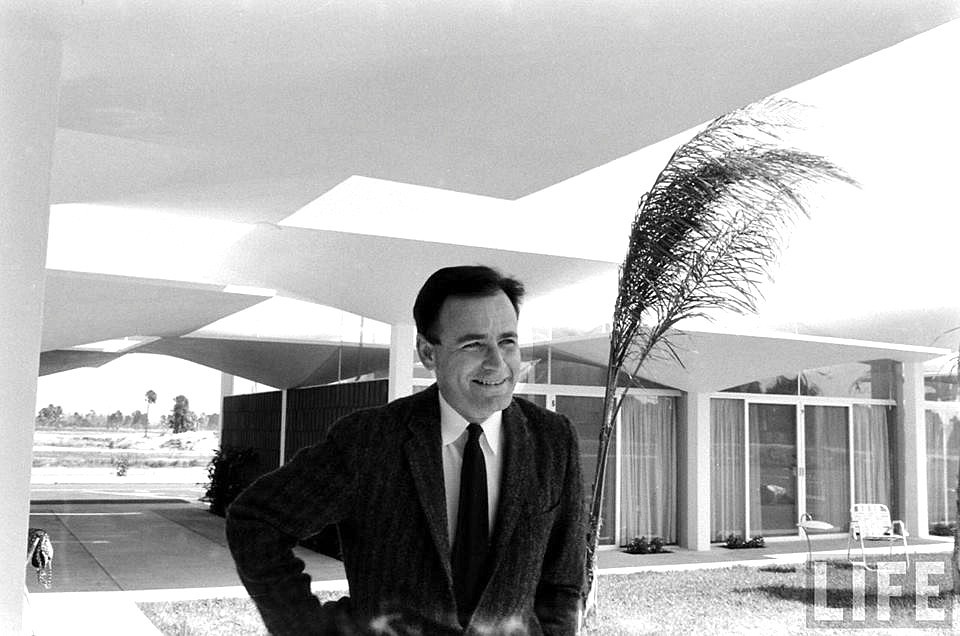- April 25, 2024
-
-
Loading

Loading

Artistry defies category. Case in point: Victor Lundy. His curvilinear buildings have the feel of sculpture.
That was the theme of “Victor Lundy: Sculptor of Space,” a 2014 documentary about his life and work. But Lundy could just as easily be called a poet of space. A romantic poet, to be precise.
This year’s SarasotaMOD Weekend looks back at Lundy’s legacy. Looking backward at his work strikes me as odd. When I first experienced it, his work seemed like the architecture of the future.
I’d seen his work up close and personal at Alta Vista Elementary School. Lundy had designed an addition there in 1958. We called it the “Butterfly Wing” because of its rows of wood beams, arched like graceful wings. (Laminated wood, I found out later.) Air-conditioning was still a luxury. Ceiling fans and outside breezes cooled the classrooms, thanks to sliding glass doors. Classes looked out on common patios and the steel cables anchoring the roof’s supporting arches to the ground. The cypress ceiling stretched above us, a cathedral of education.
Lundy had designed actual churches around town. One was just a few blocks away — the St. Paul Lutheran Church.
He’d also created the Galloway Furniture Showroom. A “showroom” indeed — revealed to outside eyes with two-story glass walls. You could look through and see more of his signature arches supporting the space. And in a gesture of humility to nature, Lundy had avoided cutting down trees. He cut a hole in the roof to let the towering pine grow through, instead. A furniture store and not a church. But I detected a family resemblance.
My father said I was right. He gave me the architect’s name, and I never forgot it.
Through the years, I saw more of Lundy’s work: The fluted concrete forms of the Warm Mineral Springs Motel. The gravity-free glass curtain of the Southgate Community Center and others.
Sadly, I saw many of his buildings remodeled beyond recognition. The Galloway Furniture Showroom now resembles “a giant hex nut,” as retired architect Jack Whelan once put it. The soaring Butterfly Wing has been anchored with steel beams. Someone painted the red brick; the walls of clear glass are gone.
Last year’s SarasotaMOD Weekend put the spotlight on Paul Rudolph. Lundy is this year’s focus — and more than his architecture will be celebrated.
His spatial poetry shows an artist’s eye. It’s not surprising he could create art on paper and canvas, as well as wood, glass and steel. In fact, Lundy’s two-dimensional art opened the door to his time as an architect in our area.
Sarasota was Lundy’s home from 1951 through 1960. Within months of arriving, his rendering of Notre Dame Cathedral won a watercolor competition. One of the jurors, Karl Bickel, was impressed. He was looking for an architect for Sarasota’s Chamber of Commerce building. Lundy gave him a watercolor of a blue-roofed pagoda, earning his first commission in Sarasota.
Lundy’s architectural drawings are masterful. But he was equally adept at human faces and images of war.
As he told me in a recent interview, he’d been a front-line infantry sergeant in the U.S. Third Army under Gen. George S. Patton. Not all of his equipment was standard United States Army issue.
“I used to carry a 3-by-5-inch sketchpad,” he says. “I’d make drawings while I was on the move. I drew pretty well — I did about 20 sketchbooks in all. Unfortunately, after I was wounded, only eight survived.”
You can see scanned images of Lundy’s surviving wartime sketchbooks at the Library of Congress. During SarasotaMOD Weekend, you can also see them at Art Center Sarasota, along with the original architectural renderings of the blue pagoda building, and several of his contemporary paintings and sketches.
Lundy had trained at New York University, studying art and architecture in the Beaux Arts method.
As an apprentice architect, he drew and painted constantly.
As a practicing architect, he continued to create on canvas and paper, creating more than 200 paintings.
Did he consider himself more of an architect or an artist?
“I consider myself both,” he says. “For me, art is architecture — and architecture is art. They’re forms of creative expression in very different media, but they come from the same place.”